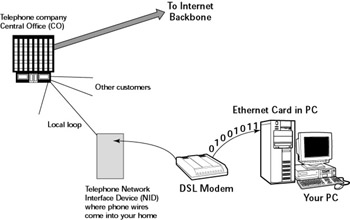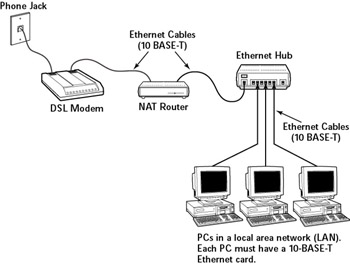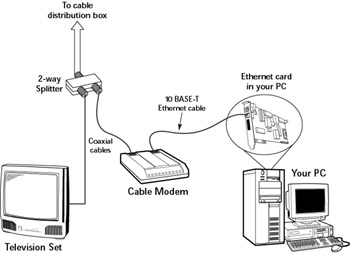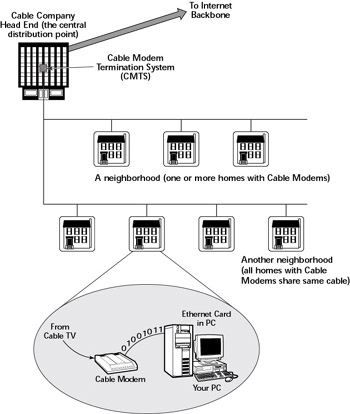Deciding How to Connect to the Internet
Deciding How to Connect to the Internet
Nowadays, you have the following popular options for connecting a small office or home office to the Internet (of course, huge corporations and governments have many other ways to connect to the Internet):
-
Digital subscriber line (DSL)-Your local telephone company as well as other telecommunications companies offer DSL-a high-speed data transmission service over a regular phone line. You can use DSL to connect your Red Hat Linux system to the Internet. In this case, you must connect a special DSL modem to an Ethernet card on your Red Hat Linux system. When you use DSL, your Red Hat Linux system is always connected to the Internet. Typically, DSL offers data transfer rates of anywhere between 128 Kbps and 1.5 Mbps. You can download from the Internet at much higher rates than when you send data from your PC to the Internet (upload). One caveat with DSL is that your home must be between 12,000 and 15,000 feet from your central office (this is a phone company facility where your phone lines end up). The distance limitation varies from provider to provider. In the United States, you can check out the distance limits for many providers at www.dslreports.com/distance.
-
Cable modem-If the cable television company in your area offers Internet access over cable, you can use that service to hook up your Red Hat Linux system to the Internet. As with DSL, connect a cable modem to an Ethernet card in your Red Hat Linux system. Typically, cable modems offer higher data transfer rates than DSL for the same cost. Downloading data from the Internet is much faster than sending data from your PC to the Internet. You can expect routine download speeds of 1.5 Mbps and upload speeds of around 128 Kbps, but sometimes you may even get higher speeds than these.
-
Dial-up networking-This is what most of us were using to connect to the Internet before DSL and cable modems came along. In this case, your Red Hat Linux system uses the Point-to-Point Protocol (PPP) or Serial Line Internet Protocol (SLIP) over a dial-up link to connect to another system already on the Internet. Usually, that Internet-connected system belongs to your Internet service provider (ISP). This method of connection is referred to as dial-up networking-establishing a network connection between your Red Hat Linux PC and another network (such as the Internet) through a dial-up modem. In this case, the maximum data-transfer rate is 56 Kbps. Most dial-up users connect to their ISP using PPP; SLIP is rarely used nowadays.
As far as costs go, DSL and cable modem service connect you to the Internet and also act as your ISP-they provide you with an IP address and give you email accounts. If you use a dial-up modem to connect to the Internet, you get the phone line from the phone company and then select a separate ISP who gives you a phone number that you dial and all the other necessary goodies like an IP address and email accounts.
Table 13-1 summarizes these three options for a small office or a home office connecting to the Internet. You can consult that table and select the type of connection that's available to you and that best suits your needs.
|
Feature |
Dial-Up |
DSL |
Cable |
|
Equipment |
Modem |
DSL modem, Ethernet card |
Cable modem, Ethernet card |
|
Also Requires |
Phone service and an ISP |
Phone service and within12,000 to 15,000 feet of central office |
Cable TV connection |
|
Connection type |
Dial to connect |
Always on, dedicated |
Always on, Shared |
|
Typical speed |
56 Kbps maximum |
640 Kbps download, 128 Kbps upload(higher speeds cost more) |
1.5 Mbps download, 128 Kbps upload |
|
One-time costs(estimate) |
None |
Install = $100-200, Equipment = $200-300, May require activation cost |
Install = $100-200, Equipment = $200-300 |
|
Typical monthly cost (2003) |
Phone charges = $20/month, ISP charges = $15-$30/month |
$50/month, May require monthly modem lease |
$50/month, May require monthly modem lease |
Note: Costs vary by region. Costs shown are typical ones for U.S. metropolitan areas.
Connecting with DSL
DSL stands for digital subscriber line. DSL uses your existing phone line to send digital data in addition to the normal analog voice signals (analog means continuously varying whereas digital data is represented by 1s and 0). The phone line goes from your home to a central office where the line connects to the phone company's network-by the way, the connection from your home to the central office is called the local loop. When you sign up for DSL service, the phone company has to hook up your phone line to some special equipment at the central office. That equipment can separate the digital data from the voice. From then on, your phone line can carry digital data that can then be directly sent to an Internet connection at the central office.
Understanding How DSL Works
A special box called a DSL modem takes care of sending digital data from your PC to the phone company's central office over your phone line. Your PC can connect to the Internet with the same phone line that you use for your normal telephone calls-you can make voice calls even as the line is being used for DSL. Figure 13-1 shows a typical DSL connection to the Internet.

Figure 13-1: Connecting to the Internet Using DSL.
Your PC talks to the DSL modem through an Ethernet connection, which means that you need an Ethernet card in your Red Hat Linux system.
Learning the DSL Alphabet Soup-ADSL, IDSL, SDSL
So far this chapter has used the term DSL as if there were only one kind of DSL. There are in fact three variants of DSL, each with different features, summarized as follows:
-
ADSL-Asymmetric DSL, the most common form of DSL, has much higher download speeds (from Internet to your PC) than upload speeds (from your PC to the Internet). ADSL can have download speeds of up to 8 Mbps and upload speeds of up to 1 Mbps. ADSL works best when your location is within about two and a half miles (12,000 feet) of your central office. ADSL service is priced according to the download and upload speeds you want. A popular form of ADSL called G.lite is specifically designed to work on the same line that you use for voice calls. G.lite has a maximum download speed of 1.5 Mbps and maximum upload speed of 512 Kbps.
-
IDSL-ISDN DSL (ISDN is an older technology called Integrated Services Digital Network) is a special type of DSL that works at distances of up to five miles between your phone and the central office. The downside is that IDSL only offers downstream and upstream speeds of up to 144 Kbps.
-
SDSL-Symmetric DSL provides the equal download and upload speeds of up to 1.5 Mbps. SDSL is priced according to the speed you want, with the higher speeds costing more. The closer your location is to the phone company's central office, the faster the connection you can get.
Setting Up a DSL Connection
To get DSL for your home or business, you have to contact a DSL provider. In addition to your phone company, there are many other DSL providers. No matter who provides the DSL service, some work has to be done at your central office-the place where your phone lines connect to the rest of the phone network. The work involves connecting your phone line to equipment that can work with the DSL modem at your home or office. The central office equipment and the DSL modem at your location can then do whatever magic is needed to send and receive digital data over your phone line.
Because of the need to set up your line at the central office, it takes some time after you place an order to get your line ready for DSL.
The first step for you is to check out the DSL providers who provide service and see if you can actually get the service. Because DSL can work only over certain distances-typically less than 2.5 miles-between your location and the central office, you have to check to see if you are within that distance limit. Contact your phone company to verify this. You may be able to check this on the Web. Try typing into Google (http://www.google.com) the words DSL, availability, and your local phone company's name. You should get a website where you can type in your phone number and learn if DSL is available for your number.
If DSL is available, you can look for the types of service-ADSL versus SDSL-and the pricing. The price depends on the download and upload speeds you want. Sometimes phone companies offer a simple residential DSL that's basically the G.lite form of ADSL with 1,500/128 speed rating-meaning that you can download at 1,500 Kbps and upload at 128 Kbps. Of course, these are the maximums, and your mileage may vary.
After selecting the type of DSL service and provider, you can place an order and have the provider install the necessary equipment at your home or office. Figure 13-2 shows a sample connection diagram for typical residential DSL.

Figure 13-2: Typical Residential DSL Connection.
Here are some key points to note in Figure 13-2:
-
Connect your DSL modem's data connection to the phone jack on a wall plate.
-
Connect the DSL modem's Ethernet connection to the Ethernet card on your PC.
-
When you connect other telephones or fax machines on the same phone line, install a microfilter between the wall plate and each of these devices.
Insider Insight Because the same phone line carries both voice signals and DSL data, you need the microfilters to protect the DSL data from possible interference. You can buy them at electronic stores or from the DSL provider.
If you also want to set up a local area network, you'd need an Ethernet hub to connect the other PCs to the network. Figure 13-3 shows a typical setup the connects a LAN to the Internet through a NAT router and a DSL modem.

Figure 13-3: Connecting a LAN to Internet through a NAT Router and DSL Modem.
Here are the points to note when setting up a connection like the one shown in Figure 13-3:
-
You need a NAT router with two 10Base-T Ethernet ports (the 10Base-T port looks like a large phone jack, also known as RJ-45 jack). Typically one Ethernet port is labeled Internet (or External or WAN for Wide Area Network) and the other one is labeled Local or LAN (for Local Area Network).
-
You also need an Ethernet hub. For a small home network, you can buy a 4- or 8-port Ethernet hub. Basically, you want a hub with as many ports as the number of PCs you want to connect to your LAN.
-
Connect the Ethernet port of the DSL modem to the Internet port of the NAT router using a 10Base-T Ethernet cable (these look like phone wires with bigger RJ-45 jacks and are often labeled Category 5 or Cat 5 wire).
-
Connect the Local Ethernet port of the NAT router to one of the ports on the Ethernet hub using a 10Base-T Ethernet cable.
-
Now connect each of the PCs to the Ethernet hub. Of course, you must have an Ethernet card installed in each PC.
Insider Insight You can also buy NAT router with built-in 4- or 8-port Ethernet hub. With combined router/hub, you need only one box to set up a LAN and connect it to Internet with a DSL modem. These boxes are typically sold under the name Cable/DSL router because they work with both DSL and cable modem.
Connecting with Cable Modem
Cable TV companies also offer high-speed Internet access over the same coaxial cable that carries television signals to your home. After the cable company installs the necessary equipment at their facility to send and receive digital data over the coaxial cables, customers can sign up for cable Internet service. You can then get high-speed Internet access over the same cable that delivers cable TV signals to your home.
Understanding How a Cable Modem Works
A box called a cable modem is at the heart of Internet access over the cable TV network. The cable modem takes digital data from your PC's Ethernet card and puts in an unused block of frequency (think of it as another TV channel, but instead of pictures and sound, this channel carries digital data).
The cable modem places upstream data-data that's being sent from your PC to the Internet-in a different channel from that used for the downstream data that's coming from the Internet to your PC. By design, the speed of downstream data transfers is much higher than upstream transfers. The assumption is that people download far more stuff from the Internet than they upload. Probably true for most of us.
| Insider Insight |
If you want to check your downstream transfer speed, go to http://bandwidthplace .com/speedtest, and click the link to start the test. For my cable modem connection, the tests reported a downstream transfer rate of about 1.4 Mbps on good days. |
Setting Up a Cable Modem Connection
To set up cable modem access, your cable TV provider must offer high-speed Internet access. If the service is available, you can call to sign up. The cable companies often have promotional offers like no installation fee or a reduced rate for three months. Look for these offers. If you are lucky, they may have a promotion going on just when you want to sign up.
The installation is typically done by a technician who splits your incoming cable into two-one side goes to the TV and the other to the cable modem. The technician provides information about the cable modem to the cable company's head end for set up at their end. When all that is done, you can plug in your PC's Ethernet card to the cable modem, and you're all set to enjoy high-speed Internet access. Figure 13-5 shows a typical cable modem hookup.

Figure 13-5: Splitting the Cable TV Signal between the TV and the Cable Modem.
The cable modem connects to an Ethernet card in your PC. So you need an Ethernet card in your PC. The cable company technician often provides an Ethernet card.
Here are some key points to note about the cable modem setup in Figure 13-5:
-
Split the incoming cable TV signal into two parts by using a 2-way splitter (the cable company technician installs this). By the way, the 2-way splitter should be rated for 1 GHz; otherwise, it may not pass through the frequencies that contain the downstream data from the Internet.
-
Connect one of the video output from the splitter to your cable modem's F-type video connector using a coaxial cable.
-
Connect the cable modem's 10 Base-T Ethernet connection to the Ethernet card on your PC.
-
Connect your TV to the other video output from the 2-way splitter.
Caution When you use cable modem to connect your Red Hat Linux PC to the Internet, the connection is always on, so there is more chance that someone may try to break into the PC. You should set the firewall setting to High Security. To configure the firewall settings, select Main Menu>System Settings>Security Level from the GNOME desktop.
Figure 13-6 shows what a typical setup with a cable modem connection being shared by a number of PCs in a LAN.

Figure 13-6: Sharing a Cable Modem Internet Connection with Several PCs in a LAN.
Here are the points to note when setting up a connection like the one shown in Figure 13-6:
-
You need a cable/DSL NAT router with two 10Base-T Ethernet ports (the 10Base-T port looks like a large phone jack-it's also known as a RJ-45 jack). Typically, one Ethernet port is labeled Internet (or External or WAN for wide area network) and the other one is labeled Local.
-
If you plan to set up a LAN, you also need an Ethernet hub. For a small home network, you can buy a 4- or 8-port Ethernet hub. Basically, you want a hub with as many ports as the number of PCs you want to connect to your local area network.
-
Consider buying a single box that acts as a NAT router and also a hub with a number of Ethernet ports.
-
Connect the video cable to the video input port of the cable modem.
-
Connect the Ethernet port of the cable modem to the Internet port of the NAT router using a 10Base-T Ethernet cable (these look like phone wires, except that the Ethernet cables have bigger RJ-45 jacks and are often labeled Category 5 or Cat 5 wire).
-
Connect the Local Ethernet port of the NAT router to one of the ports on the Ethernet hub using a 10Base-T Ethernet cable.
-
Now connect each of the PCs to the Ethernet hub. Of course, each PC must have an Ethernet card.








